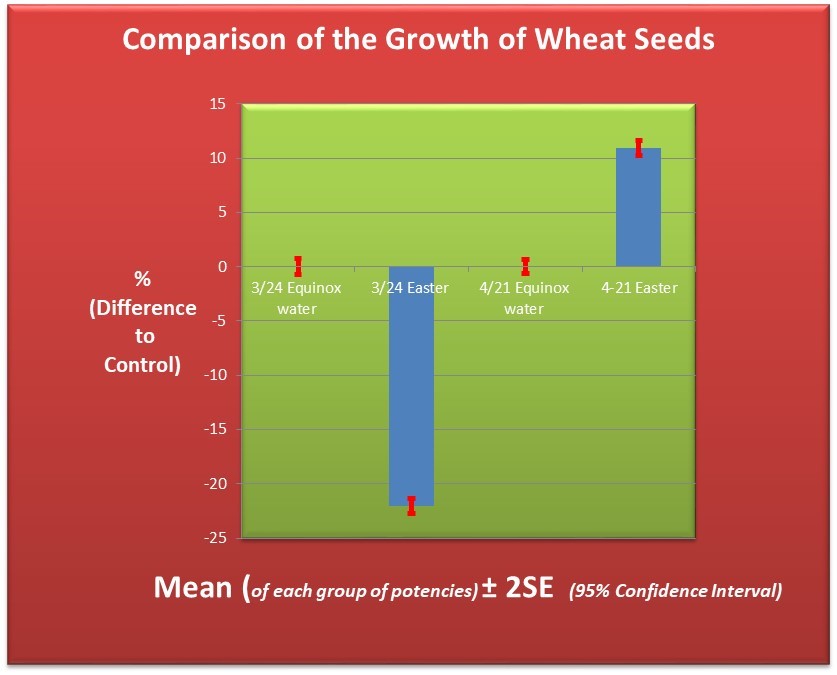When should we celebrate Easter?
The Easter date every year is set by the formula: The first Sunday after the first full moon following the spring Equinox. By far for most years this is a straightforward calculation.
However, in 2019 a relatively rare event occurred (in the last hundred years only three times) which allowed a debate to take place regarding the “real” Easter day. Without going into details here it can be said that both astronomically and by traditional acceptance two dates were considered to possibly be the “true” Easter date: March 24, 2019 and April 21, 2019.
Serious arguments were marshaled in support of their opinion by the defenders of each of these two dates.
We thought that it might be interesting to try to investigate this situation by observing the growth of wheat seeds on these particular dates.
The primary question was: Under the assumption that the “Easter phenomenon” has an additional “uplifting” effect on the life of forces in nature would the growth of wheat seeds be more stimulated on one day over the other.
We have given precise details on the methodology employed elsewhere (http://www.koliskoinstitute.org/kolisko-validation-process/) so we will give here only the necessary specifics relating to this experiment.
- Water was collected on three specific days:
- On March 21, on the so-called spring Equinox day;
- On March 24, one of the possible Easter dates;
- On April 21, another one of the possible Easter dates.
- On each of the two possible Easter dates 540 seeds were placed in small dishes, watered with the water collected on that day, allowed to grow for five days and then weighed.
- The control in comparison was done in the following fashion: The same number of 540 seeds were placed in small dishes next to the other seeds and watered with the water collected on the spring Equinox day. They were treated identical to the other experimental seeds.
We made the following observations (see the graph below):
- We found that the seeds treated with the water gathered on April 21 had a substantially more vital growth, i.e. increase in overall weight, then the ones treated with water gathered on March 24.
- The seeds that had been watered with the spring Equinox water grew identical on both dates March 24 and April 21. This was important because it removed the reasonable question of whether the seeds growing a month later would have an additional boost simply because of the passing of the season. (Incidentally, at all times the conditions within the room where the seeds were germinating were identical for both days in terms of temperature, duration of light versus dark times, etc.)
Note: In the graph the original data is presented as percent difference to control such that if the growth with the Equinox water is taken as baseline, the growth on March 24 is seen as being less by more than 20%; while in comparison to the same baseline, the growth on April 21 is enhanced by over 10%.

Conclusions:
It is not entirely clear at this point why the vitality of the seeds under the effect of the water on March 24 is so much less than the vitality of the seeds grown under the influence of the spring Equinox water. Possibly, one could make the case that the water gathered on March 24 is simply a “random” water from the point of view of nature while the Equinox water has a special quality in it that in comparison to the water of March 24 is more favorably enhancing the growth of the seeds.
As mentioned above the growth of the seeds under the influence of the Equinox water on the two chosen dates is very stable, actually identical.
In relationship to the Equinox water, the water gathered on April 21 has a significantly heightened effect on the vitality i.e. the growth of the seeds.
If one accepts the view that the Easter event as such has not only a Resurrection-like effect and Ego strengthening influence on the human being, but that the Easter day also has a rejuvenating effect on the etheric life forces in general in nature, than one can surmise that April 21 was perhaps a “true” Easter day.
Of course we are not saying that one can definitively prove the existence of the Easter date through a seed growth experiment.
Nevertheless, one can draw another conclusion that seems significant to us.
Since the water gathered on April 21–which tentatively can be called “the Easter water”–had such a vitalizing effect on the seeds and thus had such a powerful effect on their etheric growth forces, we are considering using this water, from this date, in the making of the remedies for this year.
It is always gratifying to see that an experiment that was seemingly conducted at first to resolve or at least shed some additional light on a theoretical question ends up having a very practical implication.
For the Kolisko Institute Team,
(and thanking Mark Kamsler MD, Philia Kelnhofer and Corinne Horan for their decisive contributions to this project),
Ross Rentea MD